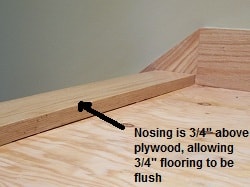
Flooring should be decided upon before you finalize your stair design. Your flooring is typically not installed until after your mill-made stair is in. By planning ahead, you can allow for your flooring (thickness) when calculating the stair, and it will make installation cleaner and simplier.
The finished flooring thickness at the bottom and top of your stair should be factored into the overall rise. By doing this, you assure that each individual rise will be a consistent height, and the flooring will flow right into the stair without gaps. By calculating your riser height from "finished floor" to "finished floor", you can be assured that your riser height will be consistent for each step. For example:
Had you not factored your finished flooring into the overall rise, the stair would be installed and then 3/4" flooring would butt up to the first riser, making the first rise 3/4" shorter than the rest. Not only would this be a trip hazard, it would not pass inspection in most areas.
At Designed Stairs, we apply a "Hold Up Block" at the bottom of the stair, under the first rise. This allows the riser to, in effect, float. When flooring is installed, it can easily slide under the riser. With this method, there is no need for special cutting of flooring materials, and it finishes out to a neat and clean look without gaps!
At the top of the stair, the nosing is held up so the flooring can butt up to it. If hardwood, the hold up is the same as the wood flooring thickness (typically 3/4", as in photo). If it's carpet, typically you want to hold it up about 3/8". This allows for the padding and bit of the carpet. You don't want to hold it up so much that you create an "edge" on the wood nosing. That edge would get beat up over time. The wood edge should be nearly buried in the carpet.
When walking a stair, a consistent rise is important. It is amazing how much our body feels an inconsistent step (more than our eyes can see it).
Installing throughout the greater Chicago area; Selling anywhere in the world
Designed Stairs
Showroom (by appointment only), Shop, and Offices
1480 E Sixth Street
Sandwich IL 60548
815-786-7600